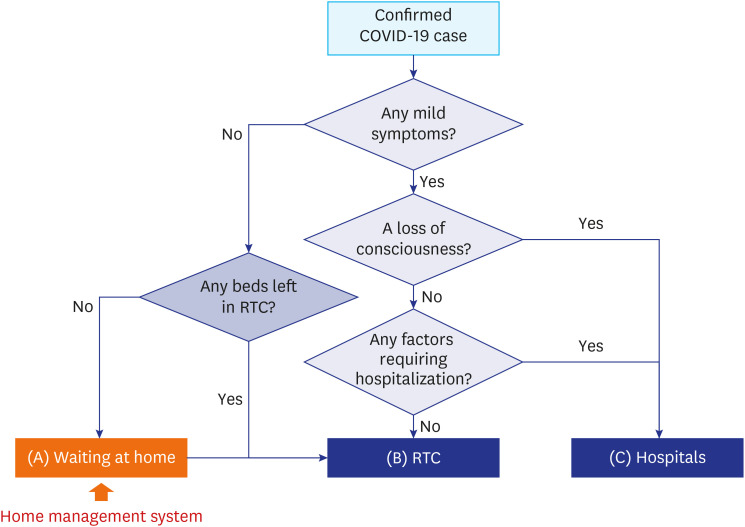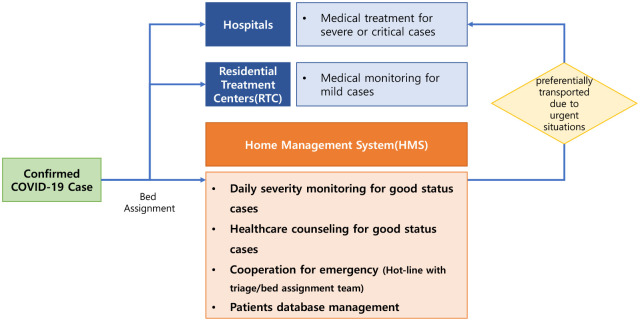4. Yang Y, Kim H, Hwang J. Quarantine facility for patients with COVID-19 with mild symptoms in Korea: experience from eighteen residential treatment centers. J Korean Med Sci. 2020; 35(49):e429. PMID:
33350187.

10. Gyeonggi Provincial Government. (COVID-19 Emergency Response Unit Regular Press Conference) Gyeonggi-do, total efforts to prepare for the shortage of beds, such as opening additional residential treatment centers and securing COVID-19 dedicated hospital beds. Updated December 9, 2020. Accessed January 22, 2021.
https://gnews.gg.go.kr/briefing/brief_gongbo_view.do?BS_CODE=S017&number=46706.
11. Yoon KJ. Infectious Diseases and Public Health Care Through COVID-19 Response. Health Welf Issue Focus. 2020; 377:1–11.
12. Choi SH. Preventive measures during outbreak of coronavirus disease 2019. Korean J Med. 2020; 95(3):134–140.

13. Choi JY. COVID-19 in South Korea. Postgrad Med J. 2020; 96(1137):399–402. PMID:
32366457.

14. Yun KW, Kim KM, Kim YK, Kim MS, Kwon H, Han MS, et al. Limited Benefit of Facility Isolation and the Rationale for Home Care in Children with Mild COVID-19. J Korean Med Sci. 2021; 36(5):e45. PMID:
33527787.

25. Central Disaster Management Headquarters, Central Disease Control Headquarters. Appendix of Guidelines to Prevent the Spread of COVID-19 for Local Government (version 9-2). Seoul, Korea: Central Disaster Management Headquarters, Central Disease Control Headquarters;2020.
26. Home Management System Taskforce, Gyeonggi Public Health Policy Institute. The Manual for Development and Operation of Home Management System (version 2.1). Seongnam, Korea: Home Management System Taskforce, Gyeonggi Public Health Policy Institute;2020.
27. COVID-19 Joint Response Control Center. The Manual for Onsite Response Team of Metropolitan Area. Seoul, Korea: COVID-19 Joint Response Control Center;2020.
29. Subbe CP, Kruger M, Rutherford P, Gemmel L. Validation of a modified Early Warning Score in medical admissions. QJM. 2001; 94(10):521–526. PMID:
11588210.

30. Royal College of Physicians. National Early Warning Score (NEWS): Standardising the Assessment of Acute Illness Severity in the NHS. Report of a Working Party. London, UK: RCP;2012.
31. COVID-19 Emergency Response Unit of Gyeonggi Provincial Government. Proposal for Establishment and Operation of Gyeonggi Provincial COVID-19 Management System(G-CoMS) Response to COVID-19 Surge. Suwon, Korea: COVID-19 Emergency Response Unit of Gyeonggi Provincial Government;2020.
33. Central Disaster Management Headquarters, Central Disease Control Headquarters. Guidelines to Prevent the Spread of COVID-19 for Local Government (version 9-4). Seoul, Korea: Central Disaster Management Headquarters, Central Disease Control Headquarters;2020.
34. Schaffer DeRoo S, Pudalov NJ, Fu LY. Planning for a COVID-19 vaccination program. JAMA. 2020; 323(24):2458–2459. PMID:
32421155.



